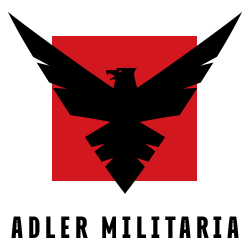Showing 1–9 of 1096 resultsSorted by latest
-
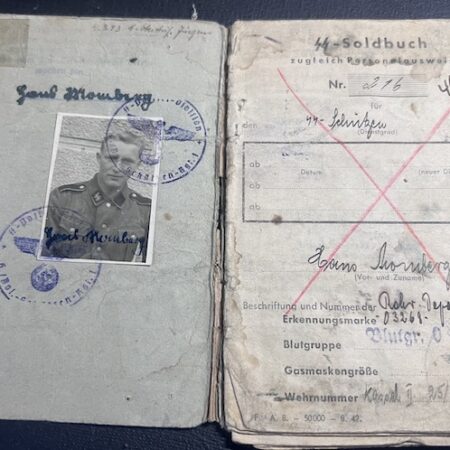
Original WWII German Waffen SS Soldbuch – SS Schütze Han Homberg – SS Sniper MIA / KIA – Gesichtsmaske – SS Panzer Grenadier Regiment 7 (Reserved)
Nice original Soldbuch from an SS Sniper, Served with SS Polizei Panzer Grenadier Regiment 1 The regiment remained outside Leningrad throughout 1942, participating in the heavy defensive battles there. On January 12, 1943, the Red Army launched its winter offensive on the northern front. When Russian troops managed to break through to the south of the XXVI Army Corps, the SS Police Division, including the 1st SS Police Infantry Regiment, received orders four days later to liberate Schlüsselburg and free the German troops trapped there. However, the Germans were unable to mount any resistance to the Russian attacks. Schlüsselburg had to be abandoned. During the heavy fighting in the Sinyavino area, the SS Police Division was almost completely destroyed. On January 29, 1943, the remnants of the regiment were withdrawn from the front and transferred to the LIV Army Corps. The division reassembled in Sablino. Nominally, the regiment was renamed SS Police Grenadier Regiment 1 here on February 1, 1943. In practice, the division’s three SS Police Grenadier Regiments were reduced to three weak battalions. The division received 1,200 replacements from Germany on February 9, 1943. Fighting subsided at the end of February 1943. On March 18, 1943, the Red Army launched another offensive, but halted it after two weeks. A comprehensive reorganization of the division and regiment then began at the Heidelager training area, culminating in its transformation into SS Police Panzergrenadier Regiment 1 on June 6, 1943. On October 22, 1943, the regiment was finally renamed SS Panzergrenadier Regiment 7. SS Panzer Grenadier Regiment 7 The regiment was formed on October 22, 1943. Initially, it bore the name SS Police Panzergrenadier Regiment 1, which in turn had previously been called SS Police Infantry Regiment 1. The regiment was subordinate to the 4th SS Police Panzergrenadier Division. On June 10, 1944, the regiment killed over 300 Greek civilians near Distomo following a partisan attack. It seems that shortly after he was deployed again with the division on the Eastern Front. Although by that stage of the war the front was on Germanys doorstep (Poland) where he was reported to have went MIA/KIA in February 1945. Equipment One of the rarest entries I have seen to date in the equipment list is the issuing of all three items together, in July 1943. Tarnjacke (SS Camo Jacket or Smock), Stahlheluberzug (SS Helmet Cover), Gesichtsmaske (Face Mask!!). Also note the issing of a Sniper Scope at the top of the weapons/equipment page for July 1943 the same time he was given the full camo equipment.
-
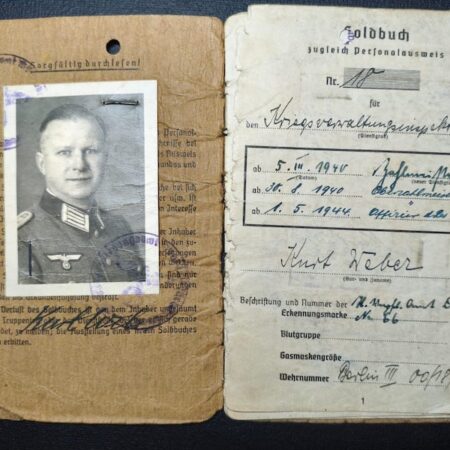
Original WWII Soldbuch – TSD Offizier Weber – Berlin 1945 – Döberitz / Wundsorf
Interesting Soldbuch, (although sadly missing pages) issued at Döberitz Training base to Kurt Weber, from Berlin Karlshorst. He was awarded the War Merit Cross with the HVA in Wunsdorf. (Units and Personal Information are still inside along with a photo of Weber in Uniform!) He served with: Heeresverflegungsamt Döberitz Interesting Barracks, today in ruins outside Berlin and can be visited on tours. Döberitz military training area, a major military installation near Berlin used by the Prussian Army, the Wehrmacht, and later Soviet forces until 1992. It served as a large-scale training ground for troops, a site for officer and pilot training, and a testing area for new aircraft and motor vehicles. During World War II, it was also a site for training various German units, including foreign volunteers, and housed a subcamp of the Sachsenhausen concentration camp. Heeresverflegungsamt Wunsdorf Wünsdorf–Zossen military complex, south of Berlin was one of the most important German command centers during both world wars. By WWII it served primarily as: Headquarters of the Oberkommando des Heeres (OKH) – the German Army High Command. Part of the Oberkommando der Wehrmacht (OKW) – the High Command of the Armed Forces also operated from the complex. A huge underground bunker system including the famous Maybach I, Maybach II, and the Zeppelin bunker, all designed to withstand bombing. A major communications hub using the Amt 500 complex with advanced telephone, teleprinter, and cipher services. Because of its role, Wünsdorf-Zossen was sometimes referred to as “the brain of the Wehrmacht.” What happened there in April 1945 During the Soviet offensive on Berlin, the Wünsdorf–Zossen area became a major target. Key events (April 20–24, 1945): 20–21 April: Soviet forces of the 3rd Guards Tank Army and 28th Army reached the area during their rapid advance toward Berlin. Fighting around the base occurred as German rear units and training formations attempted to defend the complex. The Luftwaffe bombed nearby areas trying unsuccessfully to halt the Soviet breakthrough. 22–23 April: The Soviets overran the positions around Zossen. The Maybach bunkers and the OKH/OKW command complex were captured almost intact because German forces had evacuated most leadership personnel shortly beforehand. 24 April: The entire Wünsdorf military complex fell under Soviet control. Large stores of documents, communications equipment, and intact bunkers were seized. Weber was in March of 1945 in Wunsdorf, and seems he was captured by the Red Army shortly after during the Battle of Berlin and for some reason was pressed into some sort of service given there is entries of payments by the Red Army in Russian language.
-
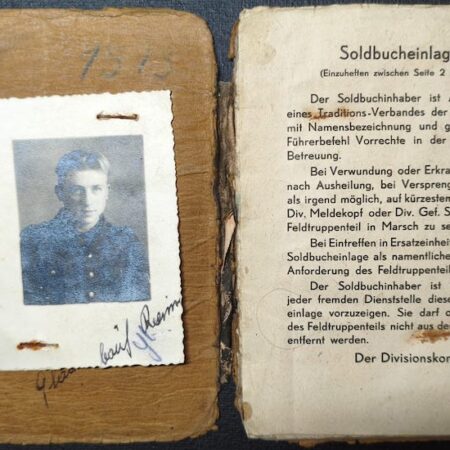
Original WWII Wehrmacht Soldbuch – Raimund Glanbauf – MG Gunner – 44 Reichs Grenadier HuD Division – Italy 1944 – Battle of Monte Cassino – Stepped on a Mine – War Crimes in Italy / Massacre of Capistrello – Interesting Photo! (sold)
Soldbuch to Raimund Glanbauf Page 1 is sadly missing, but the important information still is inside. He served with Pioneer Batl 80 – 44 Reichsgrenadier Division – Hoch und Deutschmeister From the Alpine border to Monte Cassino Following the armistice between Italy and the Allies on 8 September 1943, the division played a central role in disarming and interning Italian troops in the Trentino and South Tyrol regions. In October 1943, it was transferred to the Operational Zone of the Adriatic Littoral, where it engaged in anti-partisan operations in Istria and Slovenia. In late November 1943, the division was redeployed to Southern Italy, holding positions along the Gustav Line near Monte Cairo and the surrounding area. It took part in the Battle of Monte Cassino, suffering heavy casualties during the fighting. On 4 June 1944, near the Capistrello train station, soldiers from Pioneer Battalion 80 executed a group of Italian civilians arrested during these searches. The massacre of Capistrello At the start of the Allied offensive in May 1944, the division was stationed in the sector east and northeast of Roccasecca. Following the collapse of the Gustav Line, its troops retreated along the Roveto Valley toward Balsorano. During the retreat, they conducted search operations in the hills around Capistrello, where partisans and British parachutists were believed to be hiding. On 4 June 1944, near the Capistrello train station, soldiers from Pioneer Battalion 80 executed a group of Italian civilians arrested during these searches. The retreat through Umbria and the Casentino In its continued retreat, the division moved through the Sabina region in Latium toward Rieti and Leonessa, eventually advancing into Umbria. Along its route north, it passed through towns such as Terni, Assisi, Città di Castello, Umbertide, Sansepolcro, and Pieve Santo Stefano. In early July 1944, the division carried out anti-partisan search operations in the Monte Santa Maria Tiberina area and engaged in combat in the Perugia region. Crossing into Tuscany, the division advanced through the Casentino mountain region and established positions at the Passo dei Mandrioli. On 20 and 21 August 1944, its units carried out a major operation, code-named Maskenball, near the pass and the village of Badia Prataglia. The operation aimed to clear the area of partisan forces. The Sassoleone reprisal action and combing operations in Budrio and Medicina In September 1944, the division was positioned in the northern Apennines, south of Imola and Castel San Pietro. On 24 September, the Pioneer Battalion conducted a reprisal operation in Sassoleone, during which 23 civilians were killed in response to the killing of a German officer in a partisan ambush. After suffering heavy losses in the fighting in Valsanterno, the division withdrew to the area around Budrio to reorganise. On 9 October 1944, one of its battalions carried out search operations in the towns of Budrio, Medicina, and Sesto Imolese, detaining 269 men. Two were identified as partisans and immediately executed, while 120 others were deported to Germany for forced labour. Transfer to Hungary and the end of the war In November 1944, the division was transferred to Hungary, where it fought in the Lake Balaton area. Toward the end of the war, its remaining units retreated to the Austrian-Hungarian border. To avoid capture by the Red Army, these units withdrew to Linz, where they surrendered to American forces. Other notes: He was issued either a MG42 or MG34 in 1944 – MG (Machinengehwehr) is not to be confused with MP (Machinenpistole) ! Glanbauf stepped on a mine in February of 1945, damaging the right side of his face and his right leg. For which he was given the Wounds Badge in Black. He was found fit for service again in April 1945, but what happened to him after that I was unable to find anything out. Also a really nice and rare page is entered in at the start of the Soldbuch – This describes that he is a member of a Traditions Unit and this comes with benefits. That he belongs only to that unit and that he is to be returned to the unit in the case of injury or sickness. That this paper must be shown when asked for and that it is not to be removed from the Soldbuch. Under order of the Divisions Commander! On his Photo it can be seen he is wearing his Combat Equipment Y Straps and the photo was likely taken in Italy as it is dated 1944! For more information on this unit: https://www.ns-taeter-italien.org/en/perpetrators/44th-hoch-und-deutschmeister-reichsgrenadier-division https://en.wikipedia.org/wiki/44th_Infantry_Division_%28Wehrmacht%29
-
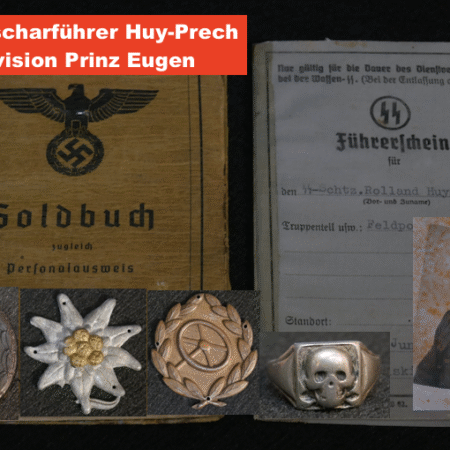
Original Waffen-SS Soldbuch Grouping – SS Unterscharführer Roland Huy-Prech – SS-Freiwilligen-Gebirgs-Jäger-Regiment 14 „Skanderbeg“ – 7 SS Division Prinz Eugen – RARE! (Reserved)
Very interesting and rare SS Soldbuch set to a unit hardly ever seen on the market. SS Soldbuch and Drivers licence issued to Roland Huy-Prech, who was a driver and technical NCO in the Stab of two Prinz Eugen GJ Regiments! Frontline units: July 1942: SS Gebirgsjäger Regiment 2 – Stabskompanie 1944/1945: SS-Freiwilligen-Gebirgs-Jäger-Regiment 14 „Skanderbeg“ Although the division was designated a “volunteer” division, very few of its men were actually volunteers. Rather, the Banat region had been declared German territory, and the men had been drafted into the Waffen-SS. The division’s equipment consisted largely of captured French, Polish, Czech, and Yugoslavian weapons and equipment. The division’s formation was completed in October 1942. It comprised 11,000 ethnic German volunteers, 22,000 ethnic Germans from Romania, 2,500 ethnic Germans from Croatia, and 2,000 Reich Germans as cadre personnel. That same month, the division was transferred to the area of Užice-Čačak-Novi Pazar-Mitrovica. On October 12, 1942, the division saw its first action against partisan units in the Kopaonik Mountains. This initial engagement, however, was largely unsuccessful. In December 1942, orders were issued to transfer to the Zagreb (Agram) area. On December 31, 1942, the division had a strength of 411 officers and 19,424 non-commissioned officers and enlisted men. In January 1943, the division, advancing from the Karlovac area towards Slunj, participated in a major operation against partisan groups in western Bosnia, targeting Bihac. This operation, codenamed “White,” also involved the 369th, 717th, and 714th Infantry Divisions. The Italian 2nd Army contributed three divisions. On January 27, 1943, the division occupied Bihac. The advance then continued on both sides of the Bihac-Bosn. Petrovac road. The division then marched south via Drvar to Bosn. Grahovo. Hindered by heavy snowfall, Drvar could not be occupied until February 27, 1943. Tito had fled the town the day before. The division assembled here until March 3rd and then attacked Bosn. Grahovo. Mostar was reached on March 15th, where the division concluded Operation White. No major operations took place in April 1943. From May 15th, 1943, the division participated in Operation Black, in which the 1st Mountain Division, the 104th Jäger Division, the 369th Infantry Division, and two Bulgarian regiments also took part. During the operation, which lasted until June 15th, there was heavy fighting with partisan units. After the operation’s conclusion, the division marched into the area north and east of Sarajevo. In July 1943, the General Command of the V SS Mountain Corps was formed from elements of the divisional staff. After some minor anti-partisan operations, the division was transferred to Herzegovina at the beginning of August 1943, with its headquarters in Mostar. Following the Italian surrender, the division received orders on September 9, 1943, to occupy the Dalmatian coast, which was largely occupied by Italian troops. The 2nd SS Volunteer Mountain Infantry Regiment was ordered to capture the strategically important city of Ragusa (Dubrovnik). Since the Italian VI Corps stationed there refused to surrender the city, the regiment was forced to capture it after a German air raid on September 12. On October 22, 1943, the division’s units were numbered. The division was now designated the “7th SS Volunteer Mountain Division ‘Prinz Eugen’,” and the mountain infantry regiments were designated “SS Volunteer Mountain Infantry Regiments 13″ and 14.” The remaining divisional units also received the number 7. From October 23rd, the division participated in Operation “Autumn Storm.” The reinforced SS Volunteer Mountain Infantry Regiment 13 was tasked with occupying the islands of Brač, Hvar, Korkula, and the Pelješac peninsula. The fighting on Pelješac, in particular, resulted in heavy losses on both sides. While this fighting continued, the reinforced SS Volunteer Mountain Infantry Regiment 14 was assigned to Operation “Landsturm” (Home Guard). The objective was to liberate the coastal strip between Split and Metković from partisans. After little success, the operation was called off in mid-November 1943. On December 2nd, 1943, the division then participated in Operation Operation “Kugelblitz” (Lightning Bolt) was launched. In cooperation with the 1st Mountain Division, the 369th Infantry Division, the 187th Reserve Division, and the Bulgarian 24th Infantry Division, three divisions of the Yugoslav People’s Liberation Army were to be destroyed in eastern Bosnia. Advancing from the southwest, the division marched via Gorazde into the area east of Sarajevo. On December 7th, it met up with the 1st Mountain Division near Gorazde and attempted to encircle the Yugoslav forces in the area of Zvornik – Priboj – Plevlja – Gorazde – Sarajevo. However, the Yugoslav units managed to break through and escape near Han Pijesac during the night of December 15th, 1943. The operation was then called off. On December 18th, 1943, Operation “Schneesturm” (Snowstorm) followed. to destroy the escaped partisan units. Heavy fighting and enemy counterattacks ensued, forcing the division to abandon this operation as well. As of December 31, 1943, the division had a strength of 21,102 men, exceeding its authorized strength by over 2,000. At this time, the division was located in the area north of Mostar. On January 4, 1944, Operation “Waldrausch” (Forest Frenzy) began, aimed at destroying the partisan groups west of the Bosna River. During this operation, on January 6, 1944, the 1st Battalion of the 13th SS Volunteer Mountain Infantry Regiment was completely destroyed. The exhausted division was briefly transferred back to Dalmatia at the end of January 1944, to the Ragusa-Split sector, and then, at the beginning of March 1944, to the area east of Sarajevo. On March 28, 1944, elements of the division were driving partisans through the towns of Otok, Gruda, and Dolac gathered the villagers in the village squares and murdered them. The likely trigger for the massacre was the Ustaša government’s plans in Zagreb to resettle ethnic German inhabitants of Slavonia. The murders were thus an act of revenge by the ethnic Germans against their Croatian allies. On April 26, 1944, Operation “Maypole” began. Its aim was to prevent Yugoslav units from crossing the Drina River into Serbia. The operation ended in mid-May 1944 with heavy losses for the Yugoslav…
-
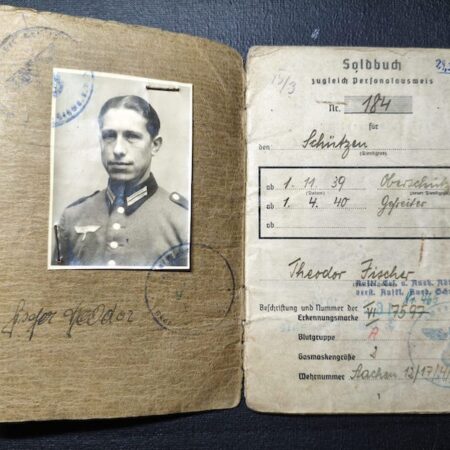
WWII Wehrmacht Soldbuch – Gefreiter Theodor Fischer – Grenzwach Regiment 46 – Siege of the Belgian Fortress Aubin-Neufchâteau 1940 !
Gefreiter Theodor Fischer from Richterich (Aachen) Germany, born in 1912 – in his civilian life he was a Miner! Soldbuch was issued in September 1939 with: Grenzwacht-Regiment 46 Unit was made up of Border troops from the Aachen area and took part in the Siege of the Belgian Fortress Aubin-Neufchâteau which was one of the forts in the Position Fortifiée de Liège (Festung Lüttich). During the 1940 Belgian campaign, Grenzwacht-Regiment 46 was known for its role in the brutal siege of the Fortress of Aubin-Neufchâteau, one of the forts in the Liège fortified position. After the fall of Fort Eben-Emael, Fort Aubin-Neufchâteau held out for eleven days against a massive German assault, including artillery, air attacks, and infantry assaults, before surrendering on May 21, 1940, due to exhaustion and lack of ammunition. The German forces, particularly the airborne troops, used a combination of glider landings, explosives, and flamethrowers to overcome the defenses, but the garrison’s valiant resistance impressed the attacking forces. Served also with: Radfahr-Bataillon 404 of the 263. Infanterie-Division in occupied Norway, and Radfahr-Abteilung 30 of the 30. Infanterie-Division. Until sometime in 1944 when he contracted some sort of stomach/intestine complains and was sent to various replacement units till the wars end. Soldbuch comes with his NSDAP Gesundheitspass which was in the rear of the Soldbuch.
-
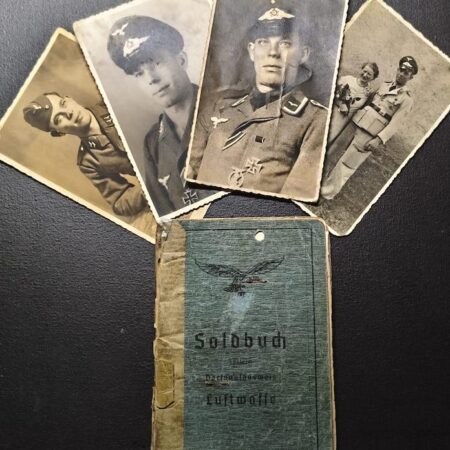
WWII Luftwaffe Soldbuch – Unteroffizier Herbert Richter – Schwere Flak Abteilung 231 – Iron Cross First Class / Flak Badge – 8.8cm Flak – Portrait Photos – Oder 1945
Richter was issued his Soldbuch in September of 1939 with the then Reserve Flak Abteilung 231. He would serve the most of the war with: Schwere Flak Abteilung 231 In 1939, the unit was stationed in Dresden, in 1940 in Belgium, and in 1941 in France. In the summer of 1942, the unit was deployed in the Bremen area. In July 1942, the unit was renamed Heavy Flak Battalion 231.. From 1943 to 1945, the unit functioned as Flak Group Vechta. By 1945 they were sent to the Oder Front. They are responsible in 1942 for claiming the downing of RAF Aircraft that crashed in Holland – info can be found on the web. He was awarded the Annexation Medal 1.10.1938, Iron Cross Second Class, Iron Cross First Class (not entered but he is wearing it in photos!), Flak Badge. A really neat little bit of paper at the front states that he was to get to his battery as soon aa any air raid was underway! His speciality was a Waffen Personal and he attended many courses as a Weapons Uffz!
-
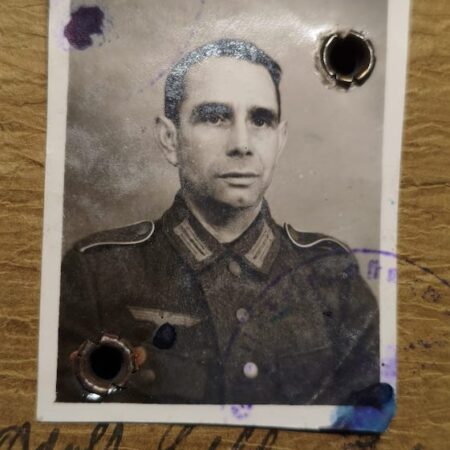
Original WWII German Wehrmacht – Soldbuch Gefr Adolf Edelkraut – Wounded in France July 1944 – 159 Reserve Division – Grenadier Regiment 74 – 19 VGD – Shot in Stomach – US 44th Infantry Division – Germany 1945
Soldbuch issued to Adolf Edelkraut born in Duisburg in 1907. Reserve Grenadier Batl 57 As part of the 159 Reserve Division they were stationed near Bordeaux France. On January 8, 1944, the division was deployed to southern France and deployed to protect the Atlantic coast. After the Allied landings in southern France, the division withdrew to Belfort, suffering heavy losses. Edelkraut was wounded with a Grenade Splinter (Soldbuch Code 31b) and delivered to hospital in Dax, France. Grenadier Regiment 74 – 19 Volks Grenadier Division In Early 1945, after healing he was deployed once again. January 3, 1945, the division was suffering heavy losses. The following weeks were characterized by hard fighting and hesitant resistance. On January 13, the division still had a combat strength of 1,500 to 2,000 men. After the costly retreat, the divisions of the XIII SS Army Corps were in the defense between Saarbrücken and Bitsch. No decisive fighting took place until the end of January 1945. Priority was given to the development of field positions and the reinforcement of the West Wall. On February 6, 1945, the US troops began a local attack against the right wing of the already severely weakened 19th Volksgrenadier Division. During these attacks, the US troops were able to capture the Blies Heights near the town of Saarguemines. The division was able to hold the remaining positions in front of the West Wall, but shrank to the strength of a weak divisional combat group. On March 15, the main attack by the American forces took place on a broad front against the West Wall. The defensive strength of the 19th Volksgrenadier Division declined rapidly, and the division was thrown back to the West Wall. On March 19, the division received orders to disengage from the front line with the remaining remnants and return to the Kaiserslautern area. In the following days, the remnants of the division were again dispersed. On March 24, it still had a strength of 400 men. On March 26, 1945, the division was officially disbanded. All that remained was the division headquarters. The remaining elements were combined into a combat group and assigned to the 2nd Mountain Division. At the beginning of April 1945, the remnants of the combat group were south of Dörzbach on the Jagst River. On April 21, the remnants of the combat group withdrew from the Crailsheim area toward Dinkelsbühl. From here, they continued toward Gingen an der Brenz. Here, their trail ends. More info: As the Allied counter-offensive against Operation Nordwind gained ground they were pushed by the US 44th Infantry Division. They fought alongside in February, then absorbed in March, the 340. Volksgrenadierdivision. The division was disbanded on 26 March 1945 in Waldangelloch, Bavaria, Germany and units were parcelled out to reinforce other units. It seems he was captured by US Forces, was badly wounded with a bullet wound in the stomach. He was quarantined due to the fact he had Typhus, and another bout of Malaria which he already had in 1943. As well as a back injury. He was released in the summer of 1946 and told to return home according to the Doctors Papers. His brother was killed in Normandy in 1944 – Wilhelm Edelkraut.
-
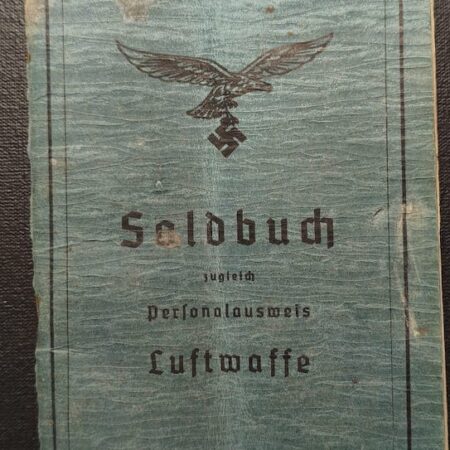
Original WWII German Luftwaffe Soldbuch – Kanonier Heinrich Helmecke – Flak-Ersatz-Abteilung 12 – Berlin 1945
Soldbuch issued in August 1943 to Kanonier Heinrich Helmecke. He was serving with – Schwere Flak Ersatz Abtlg 36 In 1944 his unit was stationed in Berlin: Schwere / Flak-Ersatz-Abteilung 12 1941/42 converted to schwere Flak-Ersatz-Abteilung 12. In 6.42 divided into: Flak-Ersatz-Abteilung 12 in Berlin-Lankwitz Flak-Ausbildungs-Abteilung 12 in Berlin-Lankwitz Service: 8.39 – 9.40 in Berlin-Lankwitz under Luftgau-Kommando III 9.40 – 8.41 in Berlin-Lankwitz under Kommandeur der Flakersatzabteilungen beim Luftgau III 8.41 – 5.45 in Berlin-Lankwitz It would seem this Soldbuch was outside for sometime, is it that he was KIA or Lost it? I was unable to find any definitive answer to this.
-
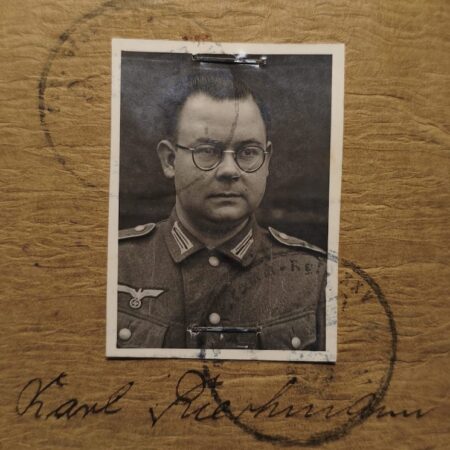
Original WWII German Wehrmacht Soldbuch – Obergefr Riechmann – Festung Lorient – Festung Lorient – Bataillon Böck – RARE!
Soldbuch opened in 1942 to Karl Reichmann. Served in the following frontline units: Reserve-Grenadier-Bataillon 467 Reserve-Grenadier-Bataillon 497 Reserve-Grenadier-Bataillon 487 Grenadier Regiment 535 On February 17, 1943, the reorganization of the regiment began within the 15th Army in France. The first units of the new regiment were assembled in the St. Omer area. After only eight weeks, the already formed elements of the regiment were relocated to the Atlantic coast of Brittany, to the area between Carnac and Saint-Nazaire, to complete their formation and be deployed for coastal defense. Festungs Stamm Reserve Kompanie XXV After the Allied landings in Normandy (June 6, 1944), the corps, under Commanding General Wilhelm Fahrmbacher, fought against the VIII US Corps (under General Troy H. Middleton with the 83rd Infantry Division, 4th and 6th Armored Divisions) in the fortresses of St. Malo, Brest, Lorient, and St. Nazaire. During the Battle of Brittany, the main attack on the fortress of Brest was launched on August 25, 1944, by the 29th Infantry Division from the west, the 8th Infantry Division from the northeast, and the 2nd Infantry Division from the east. By mid-September 1944, the 265th and remnants of the 343rd, 2nd Parachute, and 266th Infantry Divisions were under its command. Finally, only the 265th Infantry Division remained subordinate to the XXV Corps Command in the fortress of Lorient. Festung Lorient – Bataillon Böck Lorient, on the Bay of Biscay, had been an important French naval base until June 1940. With the capture of the base in the same month by German troops (see France campaign), the town in succession got more and more of strategic importance for the German Navy. This concerned above all the submarine construction with its bunker buildings on the peninsula Kéroman. U-Baot Bunker Kéroman III in Lorient In August / September 1944, following the Allied invasion of Normandy, the port and town of Lorient were completely enclosed by US and British forces, with some 22,000 German soldiers. Adolf Hitler thereupon declared the city a fortress. During the eight-month siege, which ended with the surrender of the remaining German forces on May 10th, 1945, there were some fighting going on. Battalion Böck (referred to as “Boeck” in the book) participated as a fortress assault reserve on April 30th to May 1st, 1945, in the occupation of the islands of Houat and Haedic as part of a combined sea and land operation. Mentioned in the book: Black Flag: The Surrender of Germany’s U-Boat Forces on Land and at Sea The book by Fahrmbacher: “Lorient”, 2nd edition, Prinz Eugen Verlag Weissenburg: P. 107. “The Chief of Staff of the XXV General Command, Colonel i. Gen. St. Bader, was recalled by radio order to another position in the Reich( ……………….) The Chief’s duties were now assumed by the 1st General Staff Officer, Lieutenant Colonel i. G. von Raven, and he was replaced by a proven young Ostmark native, Captain Böck.” P. 120: (Surrender) “The commanding general went there, accompanied by Lieutenant Colonel i. G. Raven, Captain Böck, and Lieutenant i. R. Buck…” At the beginning of the encirclement of the fortress of Lorient (August 10, 1944), approximately 26,000-28,000 soldiers entered the fortress, but only a very small number of these were trained infantrymen (according to FMS B-731, only approximately 800 soldiers). In addition, there were soldiers or individuals who were only partially eligible for infantry use of auxiliary weapons (approximately 3,000 soldiers for grenade launchers, anti-tank guns, 2cm anti-aircraft guns, etc.). Thus, initially, only approximately 3,800 soldiers were available for planned infantry training and further education who were even eligible for infantry use. Over time, other encircled members of the Wehrmacht, the Todt Organization, etc., were found who were ultimately trained and deployed as infantry personnel: 1,100 soldiers of the Marine Flak Artillery, 2,050 soldiers of the Marine Aircraft Personnel (including Battalion Böck, Marine Artillery Detachments 681, 683, and 688), 1,200 soldiers of the Air Force, 600 soldiers of the Signal Corps, Supply and Order Services, and the Supply Corps, as well as 1,200 members of the shipyard. Thus, a total of almost 7,000 soldiers were gathered (plus the 800 previous infantrymen), who were ultimately trained and deployed in a more or less infantry-like manner. The personnel target calculated for this, a minimal defense (need for infantry), was again, due to the circumstances (priorities, length of the front, etc.), at approximately 10,000 soldiers. Weapons K98K
